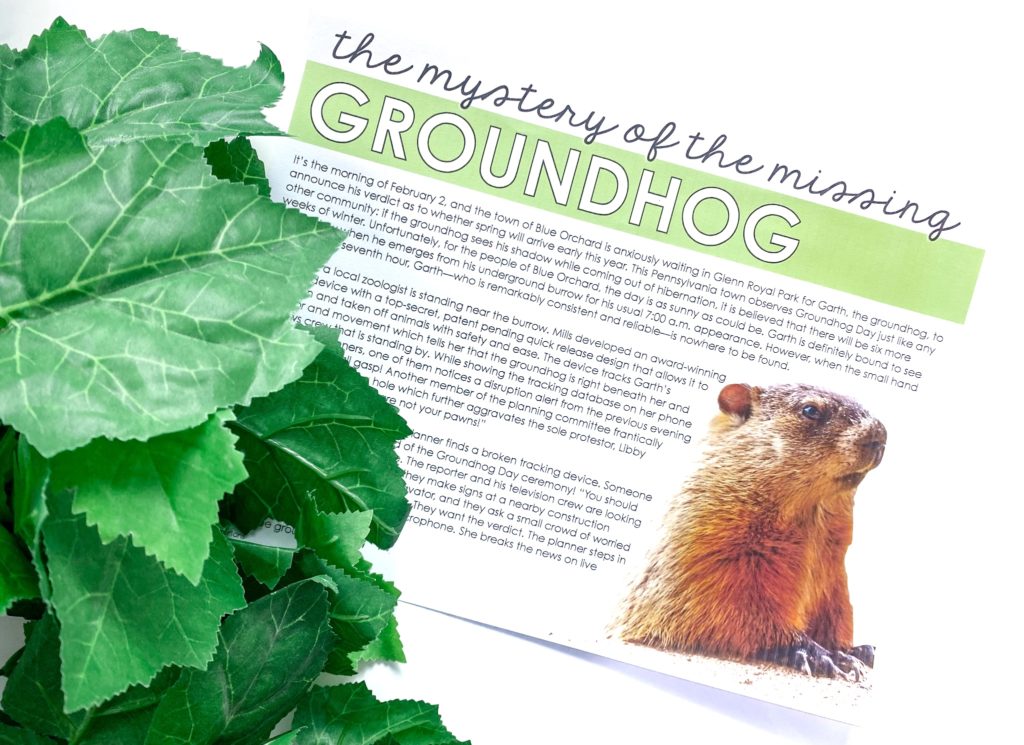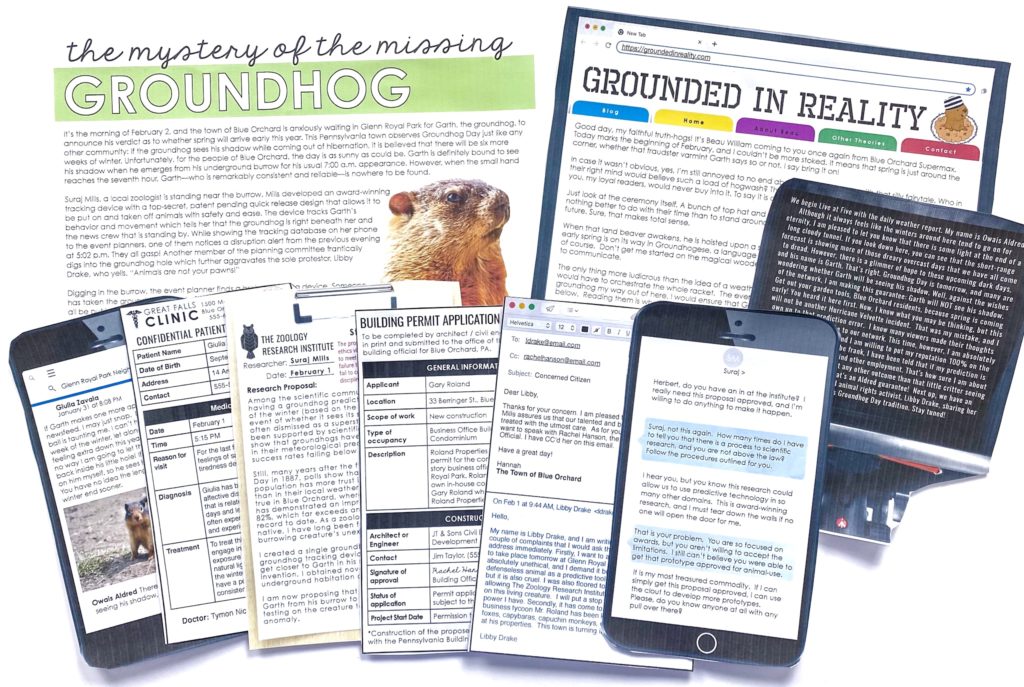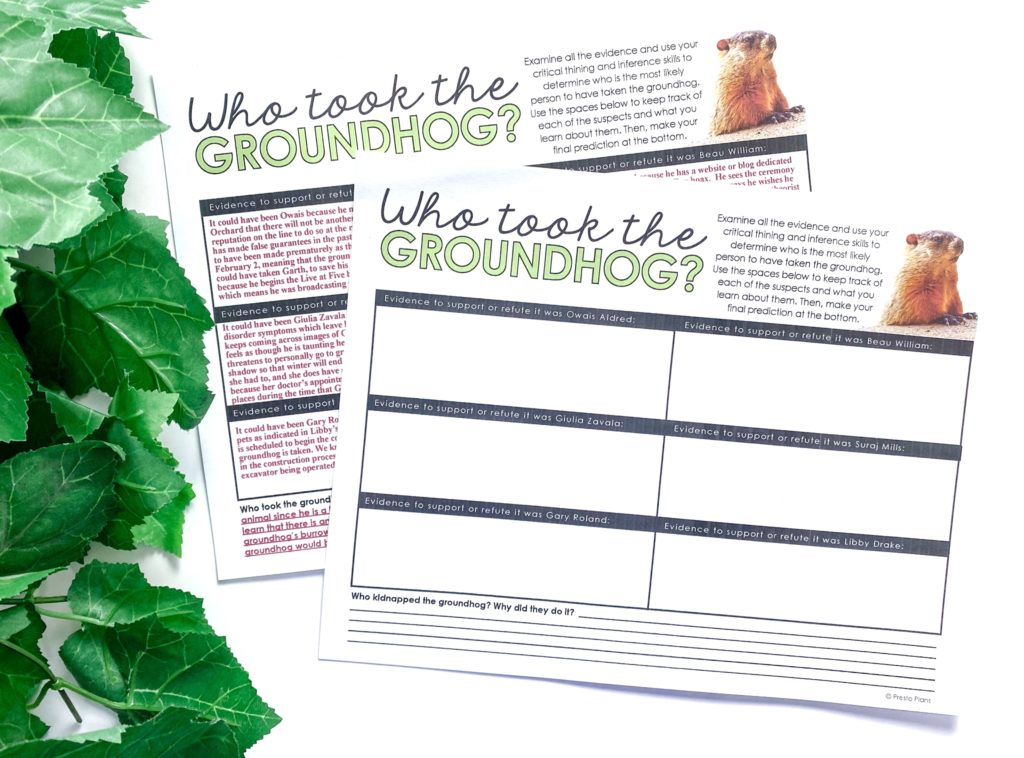PRESTO PLANS
Sent straight to your inbox
CLICK HERE TO ACCESS
Sign up to receive 10 ready-to-use ELA resources your students will love!
10 FREE ELA RESOURCES

Middle School ELA Lesson for Groundhog Day
Groundhog Day, which occurs on February 2nd each year, is a fun and lighthearted opportunity to teach your middle school students in an ELA lesson about the changing seasons, folklore, and weather prediction.
According to the tradition, if the groundhog sees his shadow, there will be six more weeks of winter. If you are like me, though, you are probably hoping for the other result—the groundhog not seeing his shadow and winter not dragging on any longer than it needs to. Winter is plenty long enough, I say!
Groundhog Day is just around the corner, and I wanted to take this opportunity to tell you about the perfect ELA activity for the occasion. The Mystery of the Missing Groundhog will challenge students to look for text evidence, infer information, and read more closely. Regardless of the verdict on February 2, this activity is a creative way to make the most out of this strange and interesting tradition in your middle school ELA classroom.
How the activity works
The first order of business here, before diving into the activity, is to introduce you to the groundhog himself, who goes by the name of Garth. Although the actual groundhog who is really the central figure in Groundhog Day folklore goes by the name of Punxsutawney Phil, the one featured throughout this mystery is named Garth…Garth the Groundhog. Catchy, right?

1. Build Anticipation
Now that you and Garth have been formally introduced, it’s time for your students to get acquainted with this groundhog—a type of rodent, also known as a woodchuck—as well.
You can start to build anticipation the day before even doing this activity with your students by cutting out a big picture of Garth and putting him up on your board. Simply write “THIS IS GARTH” beneath the picture, and watch how students, upon entering the room, quickly develop an affection for the little rodent.
Then, the next day (the day of the activity), put up the full poster for the mystery, which has the picture of Garth as well as the inscription, “Who Took the Groundhog?” Now, your students, who have already grown a certain fondness for your classroom groundhog, feel the weight of the task ahead of them. Garth is missing, and they must find him…Immediate buy-in!
2. Set the Scene
Students are now ready—more than ready—to dive into the mystery itself. This is when you can read the narrative backstory that sets the scene for The Mystery of the Missing Groundhog. You can read this as a whole class, or you can get the students to do this in small groups. Either way, they will need to be put into small groups to complete the rest of the activity. Here’s the basic premise of the mystery…
Groundhog Day is here, and a community anxiously awaits to hear the verdict from Garth, the beloved groundhog, as to whether there will be six more weeks of winter. However, when he fails to emerge from the ground for the annual Groundhog Day ceremony, the event planners realize someone took Garth from his underground burrow. Your students need to identify the guilty culprit!

3. Comb through the Evidence
To determine who kidnapped the beloved Garth (whose tiny shoulders bear the weight of an entire community anxious for winter to be over) your students will need to comb through the evidence, which includes the following…
- News teleprompter
- Blog post
- Medical report
- Social media post
- Scientific research proposal
- Building permit application form
- Text message
Combing through the evidence, students will find clues that will help them solve the mystery. This will also help them develop their close reading, text evidence, critical thinking, and inference skills, which are all essential aspects of a strong reading foundation.

4. Record the Evidence
To have any chance at finding their old pal Garth, students will need to keep track of the evidence they find. Otherwise, they might get overwhelmed with the sheer amount of leads they have—some of which more legitimate than others.
Students can record the evidence using the included graphic organizer. They might wish to assign one person in their group this task. They also may consider keeping track of everything, just roughly, on some chart paper and then putting it all together in a more organized fashion later.
In any case, the key here is for students to have textual evidence to support their findings. In other words, it can’t just be a *feeling*!

5. Group Sharing, Review, and Reflection
Once each group has recorded their evidence and has come up with who they think is responsible for Garth’s disappearance, they should be prepared to share their findings with the class. Get each group to share who they thought did it.
There will likely be some disagreement as to who is the guilty culprit, and that’s great! In this case, you can go back and look at the evidence as a class to see different groups came to different conclusions. After that, you can use the answer key to review each of the suspects individually—saving the guilty suspect last, of course. You can discuss the evidence for why or why not it could have been each person involved. Then, reveal the correct answer.
You can then finish this ELA Groundhog Day activity with some reflection. Have students think about what they did well and what they could have done better. Which mistakes did they make that could have led them down the wrong path? Which decisions did they make which helped them along the way?

There you have it! I hope you and your students have a blast with this Groundhog Day ELA activity. This mystery is one of 40 included in the full-year reading mysteries program, which you can check out by clicking here.
Looking for more tips and resources for reading instruction? Click here.
Search the blog for what you are teaching
GIVEAWAYS
sent straight to your inbox!
share this post